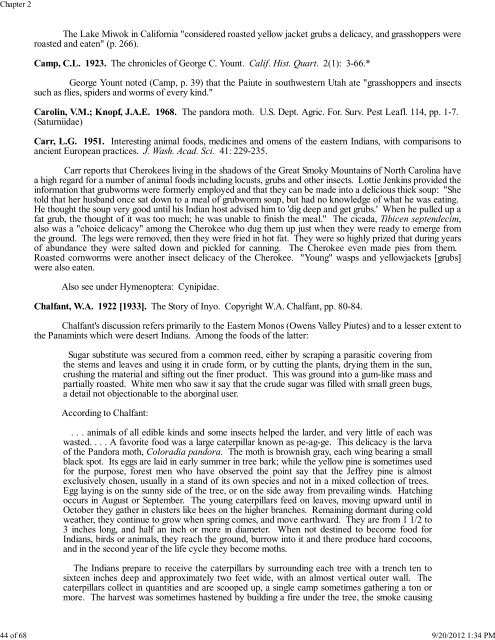Chapter 2. Insect Foods of North American Indigenous Populations ...
Chapter 2. Insect Foods of North American Indigenous Populations ...
Chapter 2. Insect Foods of North American Indigenous Populations ...
Create successful ePaper yourself
Turn your PDF publications into a flip-book with our unique Google optimized e-Paper software.
<strong>Chapter</strong> 244 <strong>of</strong> 68 9/20/2012 1:34 PMThe Lake Miwok in California "considered roasted yellow jacket grubs a delicacy, and grasshoppers wereroasted and eaten" (p. 266).Camp, C.L. 1923. The chronicles <strong>of</strong> George C. Yount. Calif. Hist. Quart. 2(1): 3-66.*George Yount noted (Camp, p. 39) that the Paiute in southwestern Utah ate "grasshoppers and insectssuch as flies, spiders and worms <strong>of</strong> every kind."Carolin, V.M.; Knopf, J.A.E. 1968. The pandora moth. U.S. Dept. Agric. For. Surv. Pest Leafl. 114, pp. 1-7.(Saturniidae)Carr, L.G. 1951. Interesting animal foods, medicines and omens <strong>of</strong> the eastern Indians, with comparisons toancient European practices. J. Wash. Acad. Sci. 41: 229-235.Carr reports that Cherokees living in the shadows <strong>of</strong> the Great Smoky Mountains <strong>of</strong> <strong>North</strong> Carolina havea high regard for a number <strong>of</strong> animal foods including locusts, grubs and other insects. Lottie Jenkins provided theinformation that grubworms were formerly employed and that they can be made into a delicious thick soup: "Shetold that her husband once sat down to a meal <strong>of</strong> grubworm soup, but had no knowledge <strong>of</strong> what he was eating.He thought the soup very good until his Indian host advised him to 'dig deep and get grubs.' When he pulled up afat grub, the thought <strong>of</strong> it was too much; he was unable to finish the meal." The cicada, Tibicen septendecim,also was a "choice delicacy" among the Cherokee who dug them up just when they were ready to emerge fromthe ground. The legs were removed, then they were fried in hot fat. They were so highly prized that during years<strong>of</strong> abundance they were salted down and pickled for canning. The Cherokee even made pies from them.Roasted cornworms were another insect delicacy <strong>of</strong> the Cherokee. "Young" wasps and yellowjackets [grubs]were also eaten.Also see under Hymenoptera: Cynipidae.Chalfant, W.A. 1922 [1933]. The Story <strong>of</strong> Inyo. Copyright W.A. Chalfant, pp. 80-84.Chalfant's discussion refers primarily to the Eastern Monos (Owens Valley Piutes) and to a lesser extent tothe Panamints which were desert Indians. Among the foods <strong>of</strong> the latter:Sugar substitute was secured from a common reed, either by scraping a parasitic covering fromthe stems and leaves and using it in crude form, or by cutting the plants, drying them in the sun,crushing the material and sifting out the finer product. This was ground into a gum-like mass andpartially roasted. White men who saw it say that the crude sugar was filled with small green bugs,a detail not objectionable to the aborginal user.According to Chalfant:. . . animals <strong>of</strong> all edible kinds and some insects helped the larder, and very little <strong>of</strong> each waswasted. . . . A favorite food was a large caterpillar known as pe-ag-ge. This delicacy is the larva<strong>of</strong> the Pandora moth, Coloradia pandora. The moth is brownish gray, each wing bearing a smallblack spot. Its eggs are laid in early summer in tree bark; while the yellow pine is sometimes usedfor the purpose, forest men who have observed the point say that the Jeffrey pine is almostexclusively chosen, usually in a stand <strong>of</strong> its own species and not in a mixed collection <strong>of</strong> trees.Egg laying is on the sunny side <strong>of</strong> the tree, or on the side away from prevailing winds. Hatchingoccurs in August or September. The young caterpillars feed on leaves, moving upward until inOctober they gather in clusters like bees on the higher branches. Remaining dormant during coldweather, they continue to grow when spring comes, and move earthward. They are from 1 1/2 to3 inches long, and half an inch or more in diameter. When not destined to become food forIndians, birds or animals, they reach the ground, burrow into it and there produce hard cocoons,and in the second year <strong>of</strong> the life cycle they become moths.The Indians prepare to receive the caterpillars by surrounding each tree with a trench ten tosixteen inches deep and approximately two feet wide, with an almost vertical outer wall. Thecaterpillars collect in quantities and are scooped up, a single camp sometimes gathering a ton ormore. The harvest was sometimes hastened by building a fire under the tree, the smoke causing
















